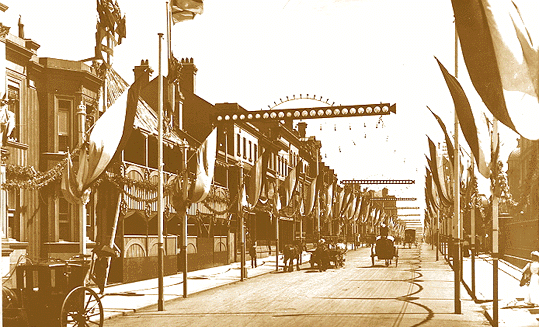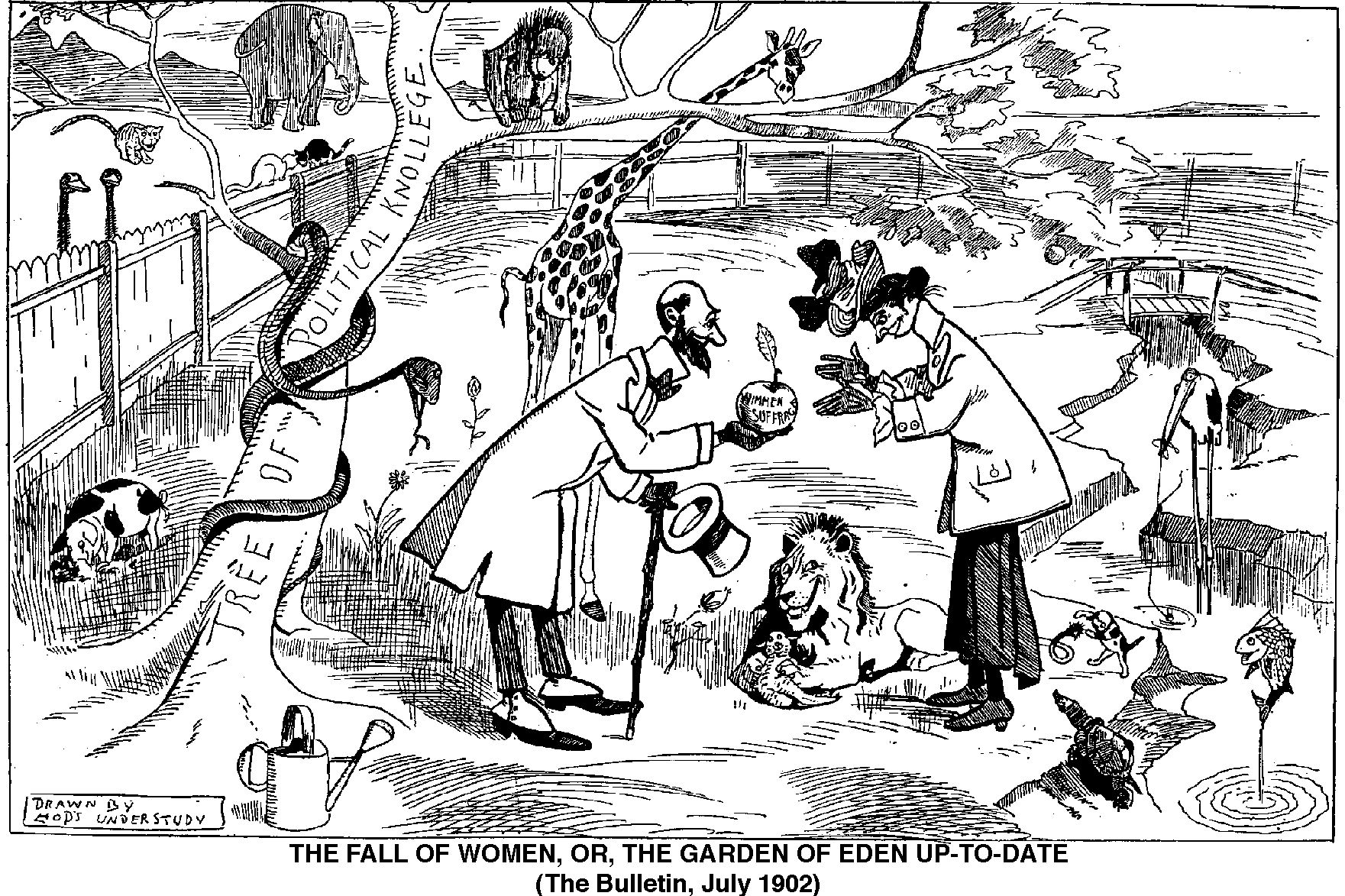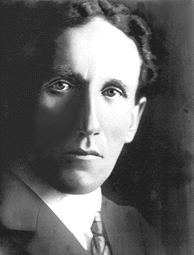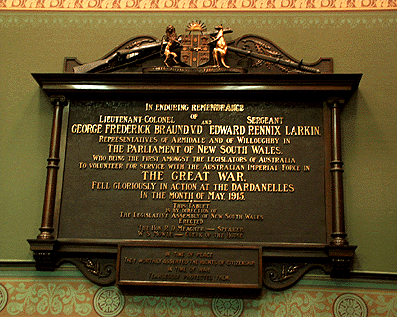Federation and the New South Wales Parliament 1901
 Macquarie Street outside Parliament House decorated for the Federation Inauguration Procession of 1 January, 1901.
Macquarie Street outside Parliament House decorated for the Federation Inauguration Procession of 1 January, 1901.
The move towards Federation of the separate Australian colonies into a single nation was one of the two great issues of the last decade or so of the century in Australia.
Federation, achieved in 1901, had a tremendous impact on the powers and role of the Parliaments of the former colonies. The Parliament of New South Wales resigned its control over defence, customs and excise, coinage, postage, etc, under the new Australian Constitution, and power to legislate over those areas went to the Commonwealth Parliament. Some people at the time wondered if there was a real role left for the State Parliament, but in fact the powers retained were substantial and limited only by the specific exclusions made in the Federal Constitution.
The many alterations to the New South Wales Constitution since 1855 were consolidated in a new Constitution Act in 1902 and, following a referendum, the Legislative Assembly was reduced to 90 to take account of the narrower responsibilities and the new level of political representation which the electors now had through their Federal Parliamentarians.
The Parliament of New South Wales also contributed substantially to the membership of the new Federal Parliament. Of the 32 representatives elected from NSW, 27 had previously been Members of the Parliament of New South Wales, including two former Premiers. The group included Edmund Barton, who became the first Australian Prime Minister, and four others who also later became Prime Minsters (John Watson, George Reid, Joseph Cook, and W. M. Hughes).
Votes for Women 1902
 As this Bulletin cartoon suggests, the gaining of the vote by women in New South Wales in 1902 was seen by some as a loss of political innocence.
As this Bulletin cartoon suggests, the gaining of the vote by women in New South Wales in 1902 was seen by some as a loss of political innocence.
Women gained the right to vote in Federal elections in April 1902, and New South Wales gave women the vote in State elections in July 1902. Gaining the vote was the culmination of a peaceful but determined struggle that brought Australian and New South Wales women to be amongst the first in the world to be able to vote.
However, entering Parliament as members was another matter. Women could stand for Federal Parliament but could not become Members of the NSW Legislative Assembly until 1918 or Members of the Legislative Council until 1926. The first woman elected to the New South Wales Parliament, Millicent Preston-Stanley (the second woman to be elected to any Australian parliament), served in the Legislative Assembly from 1925 to 1927.
The first women appointed to the Legislative Council (in 1931) were Catherine Green and Ellen Webster. However, it not until the 1980s that significant numbers of women held seats in the Parliament.
Indigenous Australians and the Vote
Unlike in several other Australian states, Aboriginal Australians in NSW were not officially prevented from voting. However, their exclusion from being counted or included by the Federal Constitution, the 1902 Commonwealth Franchise Act, together with welfare and protection acts, residential requirements and prevailing attitudes effectively denied them the vote. In 1949, all Aboriginal people who had served in the military forces or who could vote in state elections were able to vote in Federal elections. In 1962, all Aboriginal Australians gained the right to vote in all states and in Federal elections but voting was not compulsory for Aboriginal people until 1984 when it was made compulsory for all Australians.
Political Parties
The two-party system that has dominated most of the twentieth century emerged in the decade after Federation. The old Free Trade and Protectionist parties had lost the issue that divided them with the establishment of the Federal Parliament and its protectionist programs, and gradually the division that emerged was between Labor and non-Labor conservative parties. The conservative Liberal Reform Party and the first Progressive Party (1901-07) of the first decade of the twentieth century was followed in turn by the National Party (1917-32) which evolved with the split of the Labor governments over conscription, their leaders and some other members joining with the former conservative opposition. It was replaced by the United Australia Party in the 1930s and finally (in the 1940s) by the modern Liberal Party. The conservative party, under its various names, was allied almost from the beginning with the second Progressive Party which had emerged in 1915 and which, by 1925, had evolved into the Country (now National) Party. Similarly, at various times after the 1917 spilt the Labor Party again fractured from time to time, the most notable periods being during and after the 1930-32 Lang Government in NSW and in the 1950s-70s when the anti-communist Democratic Labor Party (DLP) emerged.
Many other political parties came and went in the 20th century but few of them, until the changes to the Legislative Council of the 1980s, were able to gain representation. Similarly the Parliament had only a small scattering of Independent members from time to time until the 1980s and many of these had originally been elected as party members but separated from the party during their time in Parliament.
World War I and the Conscription Split
 Premier William Holman, Labor Premier whose support for conscription helped split the party and state.
Premier William Holman, Labor Premier whose support for conscription helped split the party and state.
World War I (1914-1918) had a dramatic impact on families, the economy and politics. Australian casualties were extremely heavy for the small nation and the demand for additional recruits seemed endless. Although all state and national governments were energetic in supporting the war effort, the issue of conscription divided the nation. Divisions occurred along many lines, fracturing public opinion, particularly along religious and industrial lines. Roman Catholic Church leadership played a prominent role in opposition and the union movement, led or influenced by the IWW (Industrial Workers of the World) which opposed the war generally, undertook a series of severe industrial actions toward the later years of the war. These actions were vigorously opposed and suppressed, even by governments which had been elected as Labor representatives.
The Australian army (AIF) was one of the few forces in France entirely made up of volunteers. With heavy casualties mounting and voluntary enlistments falling short of reinforcement needs, the Federal Labor Government under Prime Minister William Morris (“Billy”) Hughes began to campaign vigorously for the introduction of conscription. In 1916 and again in 1917, amidst bitter division, Hughes’ government put the issue to the people in referendums. The proposal was defeated both times, narrowly the first, more decisively the second. The decision to pursue conscription split both the national and NSW Labor governments, and their respective leaders (Hughes, nationally; and Holman in New South Wales) retained power by forming new Nationalist coalitions with their former conservative opponents. Conscription was defeated but the wounds of the division took longer to heal.
During the war, a number of members and staff of the Parliament of New South Wales, served with the armed forces. When Australian troops first went into action at Gallipoli in April, 1915, at least two serving members were amongst the forces landed there. Sergeant Edward Larkin, Labor member for Willoughby, died on the day of the Gallipoli landing, April 25, although his body was not recovered until June (accounting for the incorrect information on the wartime plaque). Later in May, 1915, Lt-Col. George Braund, Liberal member for Armidale, was also killed in the Gallipoli fighting. Memorial plaque in the Legislative Assembly to two Members killed at Gallipoli in May, 1915.

